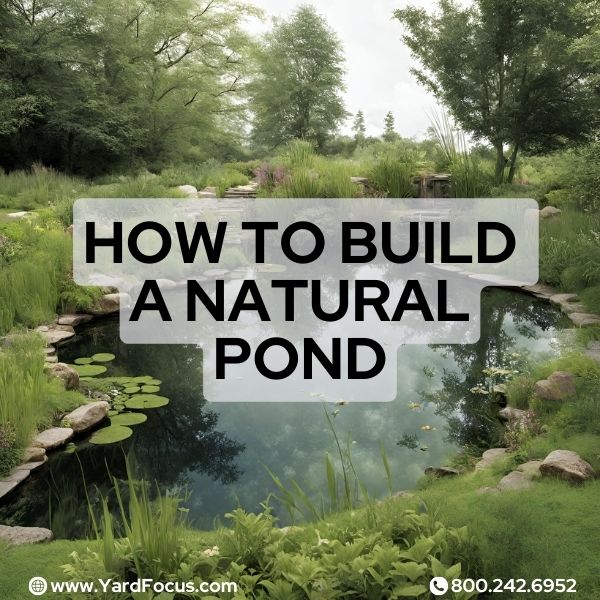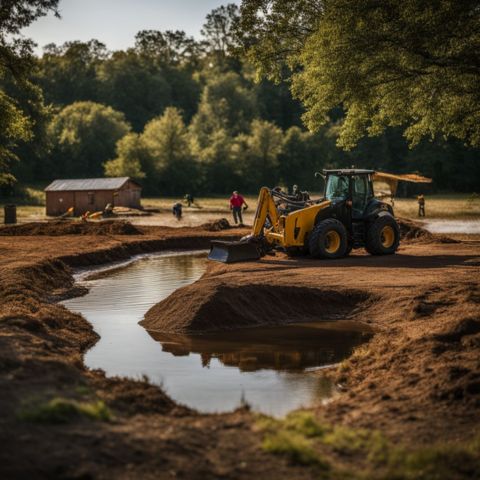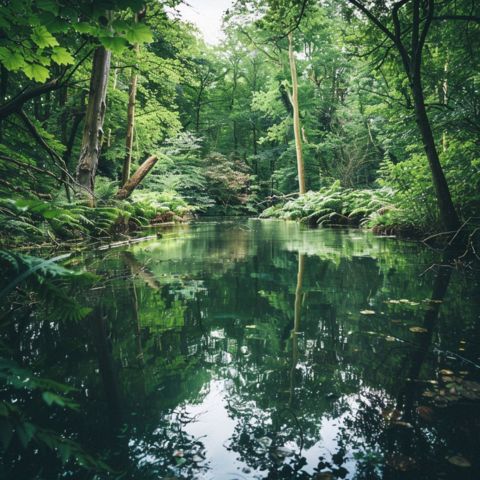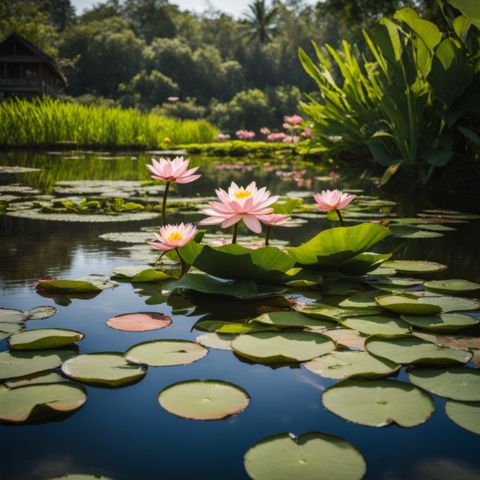
How To Build A Natural Pond
Knowing how to build a natural pond can transform your backyard into a vibrant oasis.
A natural pond attracts beneficial creatures, creating a miniature ecosystem. This guide will help you construct a thriving water feature step-by-step.
Embrace nature's wonders in your backyard.
What is a Natural Pond?
A natural pond mimics nature. It nurtures biodiversity by creating habitats for aquatic plants, insects, amphibians, and fish.
Unlike artificial ponds with pumps and filters, natural ponds rely on microorganisms and plants to maintain water clarity.

The edges blend seamlessly into the surroundings, with shallow areas for emergent vegetation.
Natural ponds utilize nutrients from decaying organic material like leaves and twigs, which nourish microbes that help break down waste.
However, excessive organic material can lead to nutrient overload and water quality issues.
Carefully selected aquatic plants help control nutrient levels, preventing algae overgrowth.
With the right balance, these self-sustaining ecosystems require minimal intervention after establishment.
Steps to Build a Natural Pond
Digging the hole correctly is crucial. You must dig a hole deep enough to accommodate plants and creatures.

Using bentonite clay, a natural material, to line the pond base can create a watertight barrier.
This may reduce the need for synthetic liners and help prevent water seepage into the surrounding soil, though it's not always as effective as synthetic options.
Digging the Hole
Selecting the right spot is crucial. Measure the desired pond size and mark the area.
Begin excavating soil gradually, creating sloping edges for aquatic life entry and exit.
Dig the deepest section in the center, around 18-24 inches deep, for year-round water.
The hole preparation lays the groundwork for a thriving natural pond ecosystem.
Clearing out Rocks
Remove any rocks, roots, or debris during the digging process. Clearing out rocks is an essential step after digging the initial hole.
Clearing rocks first will aid in the clay application as rocks can disrupt the clay layer. A smooth foundation allows the clay to work well.
Adding Bentonite Clay
Adding bentonite clay is crucial for building a natural pond. Bentonite expands and seals gaps when wet.

It forms a waterproof lining without needing artificial liners. Spread several inches of bentonite evenly across the pond base.
Compact the bentonite well with a tamper tool. Ensure there are no dry pockets or cracks left.
This dense clay layer prevents water seepage into the ground. It creates an impermeable barrier for the pond water.
Creating Hiding Features for Pond Creatures
After applying bentonite clay lining, create shelters for aquatic life. Strategically position pebbles and rocks to form crevices.
Small creatures seek sanctuary from predators. Partially bury logs or hollow tiles.
These dark spaces appeal to fish, amphibians, and invertebrates. Varied habitats nurture biodiversity in the natural pond ecosystem.
Adding Pebbles for Extra Protection
Layer pebbles along the pond's edge. Pebbles will help prevent erosion.
Rocks and pebbles form a necessary barrier that protects the pond's softer edges and supports the establishment of aquatic plants by anchoring their roots.
Scatter flat stones on submerged shelves. Stones create spaces for fish to rest. Lay river rocks on shallow slopes. The rocks help aquatic creatures navigate the shorelines.
Stabilizing the Edges
Stabilize pond edges with coconut fiber mats. These mats provide stability and protection.

Secure pond edges with native plants like greater pond-sedge, water mint, and water crowfoot.
The roots anchor the soil, preventing erosion. Shallow areas create perfect habitats for frogs, dragonflies, and other creatures.
Creating Protected Habitats in Shallow Areas
Shallow areas of natural ponds provide vital habitats for aquatic creatures. Create hiding places using rocks, logs, and aquatic plants to shelter small fish, frogs, and insects.
Potamogeton lucens and frogbit offer protective cover for egg masses and hatchlings.
Gently slope the shorelines to enable easy access for birds and other wildlife. Shallow pond zones nurture biodiversity and maintain ecological balance.
Filling up Water in the Pond
Pond water levels will rise naturally from rainfall, groundwater, or nearby streams.
You can fill ponds directly using a garden hose. You'll want to introduce water slowly to avoid erosion. Allow rainwater to fill first before using the garden hose for topping off.
Afterward, it can be maintained with natural sources like rainfall or connecting waterways.
Maintaining a Natural Pond
Maintaining a pond takes effort. It requires promoting good microorganisms. These break down debris and fish waste.

Water plants help control nutrients. They reduce algae growth by limiting sunlight. Use plants like water lilies and lotuses.
Promoting Microorganism Growth
Microorganisms play a crucial role in maintaining a healthy natural pond ecosystem.
Beneficial bacteria and other microscopic creatures help break down organic matter, keeping the water clear and oxygenated.
Promoting their growth is essential for a thriving pond environment.
Establishing a diverse community of microbes in your pond aids in nutrient cycling and prevents stagnation.
Introduce beneficial bacteria from an established pond or purchase commercial products specifically formulated for ponds.
Controlling Nutrient Levels with Water Garden Plants
Water garden plants play a crucial role in controlling nutrient levels in natural ponds.
Species like arrow arum, water iris, and cattail absorb excess nutrients, preventing algae overgrowth.

Additionally, water lilies reduce sunlight penetration, inhibiting algae growth.
Aquatic plants act as natural filters, removing compounds like nitrogen and phosphorus.
Strategically placing these plants throughout the pond creates a balanced ecosystem.
Floating plants shade the water surface, deterring algae proliferation, while submerged varieties oxygenate the pond.
Reducing Algae Growth by Limiting Light
Algae growth thrives in sunlight. Shading the pond limits algae bloom. Plant trees and shrubs around the pond's perimeter to cast shade.
Alternatively, float water plants with large leaves on the surface to block sunlight penetration.
Duckweed and water lilies reduce light exposure effectively. This strategy controls algae naturally without using chemicals.
Enhancing Your Pond with Water Garden Plants
Planting water garden plants transforms a natural pond into a thriving ecosystem. Hardy water canna, water iris, and water lily add color and texture.
These flowering aquatics provide hiding spots for fish and frogs.

Arrow arum, broadleaf arrowhead, and bulrush purify the water through absorption.
Pickerel rush and corkscrew rush soften the pond's edges with graceful foliage. An umbrella plant's broad leaves provide shade, reducing algal blooms.
Carefully position vegetation to create sheltered zones for tadpoles and beneficial insects. A balanced selection cultivates a self-sustaining aquatic habitat.
Incorporating varied water garden plants is key to a vibrant natural pond.
Secrets to a Successful Natural Pond
Achieving a thriving natural pond requires an understanding of the intricate ecological balance.
Promote beneficial microorganism growth by providing surfaces like logs and rocks. These organisms aid in nutrient cycling and water purification.
Strategically place aquatic plants to control nutrient levels, preventing algae blooms.
Oxygenators like shining pondweed release oxygen, while floating plants like water lilies limit sunlight penetration, reducing algae growth.
Incorporate varying depths to create diverse habitats. Shallow areas with gravel substrates shelter tiny creatures and egg masses.
Gently sloping edges allow easy access for wildlife.
Partially submerged logs provide essential hiding spots for frogs and ideal perching areas for birds, enhancing the pond's biodiversity.
A balanced ecosystem attracts fascinating biodiversity, from dragonflies to raccoons, transforming your backyard into a serene nature haven.
FAQs
What are the benefits of having a backyard pond?
Backyard ponds are garden water features that provide a nutritious environment for goldfish and other aquatic life.
Is it difficult to build a natural pond?
Building a natural pond requires careful planning and does not typically involve installing a mechanical filtration system, focusing instead on creating a balanced ecosystem.
Can I have a beach area near my pond?
Yes, you can create a beach area around your natural pond, which can add a unique and inviting touch to your water feature.
What should I consider when designing a natural pond?
When designing a natural pond, consider factors like size, depth, and location to ensure it complements your overall garden theme and provides a suitable habitat for the desired aquatic life.
Conclusion
Discovering how to build a natural pond rewards you with a sustainable ecosystem.
Water features attract birds and amphibians, enriching biodiversity. Start small, and learn through experience before scaling up.
Utilize bentonite clay and pebble layers for structure. Stabilize edges using fiber mats.
Cover half the surface with aquatic vegetation to control algae growth. Carefully select plants that thrive in ponds.
Enjoy this low-maintenance, self-cleaning water garden that harmonizes with nature's rhythms.

